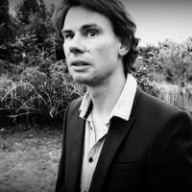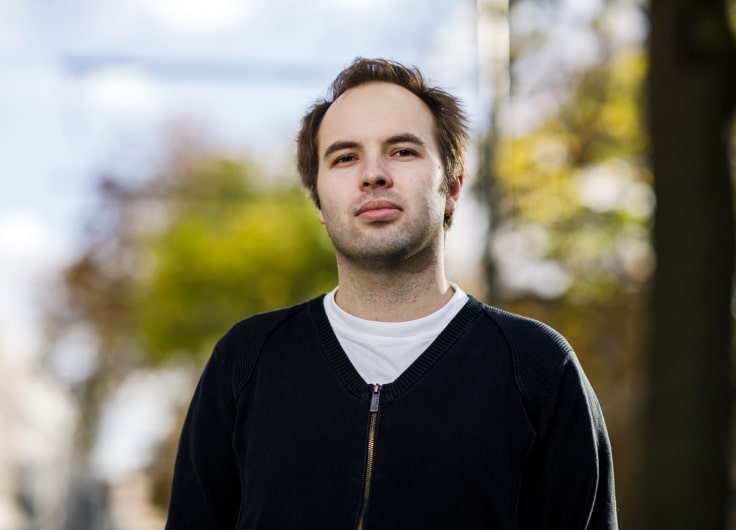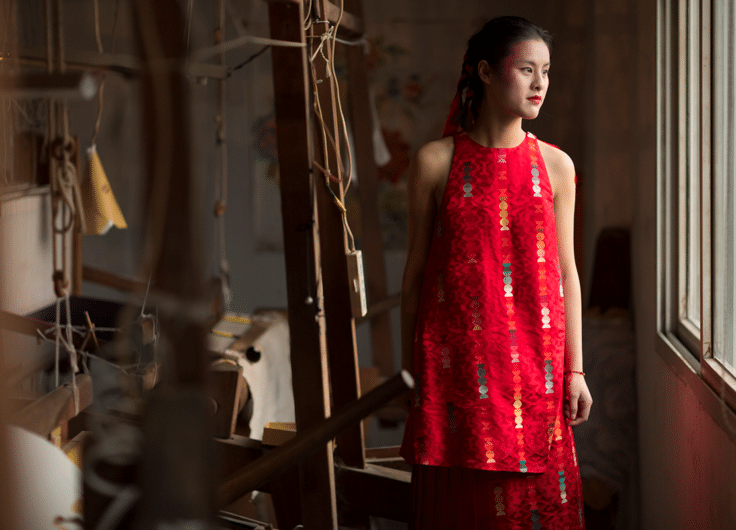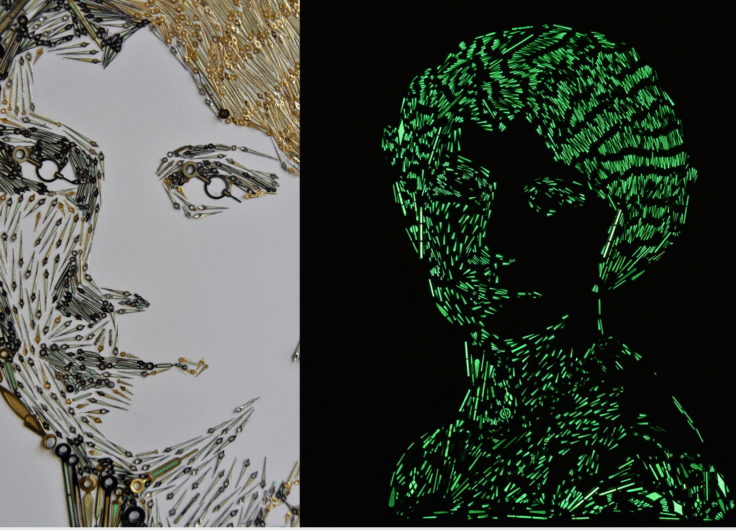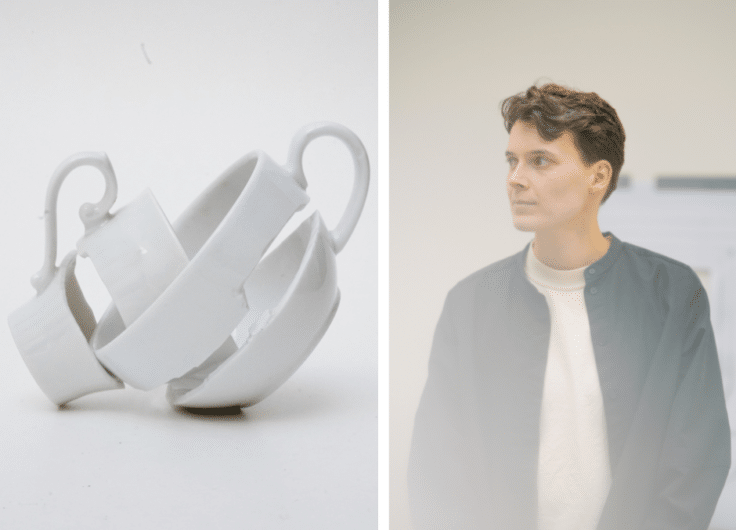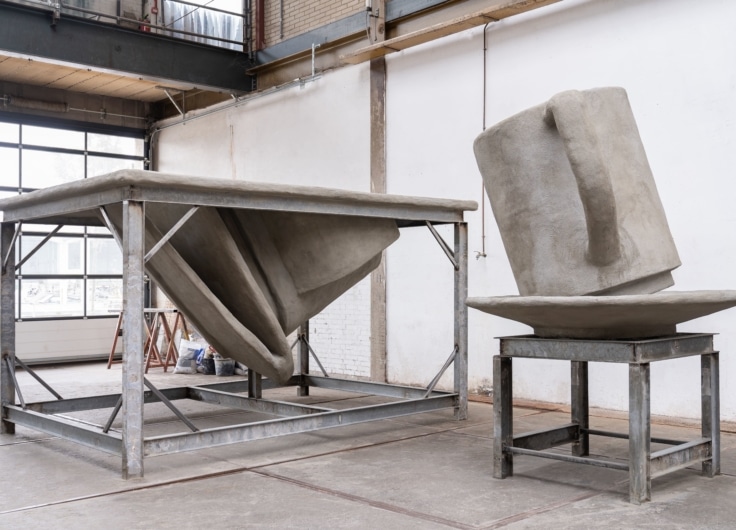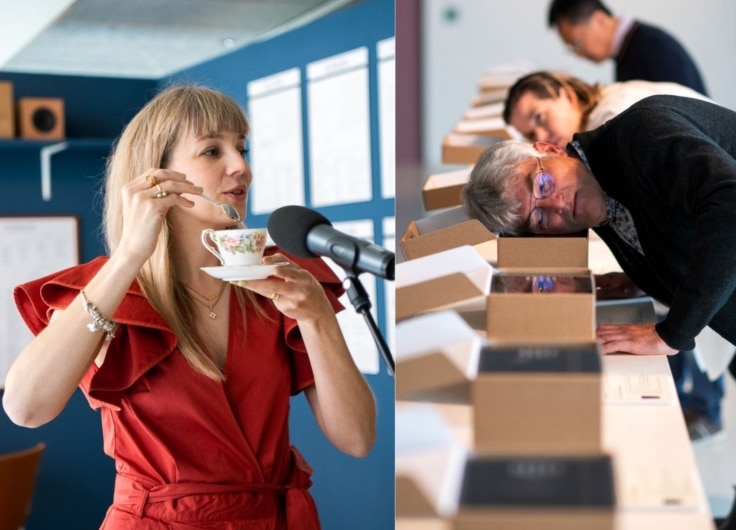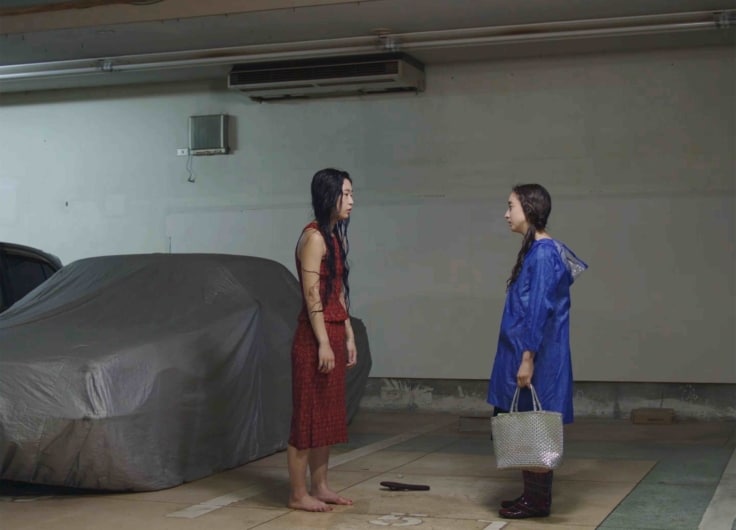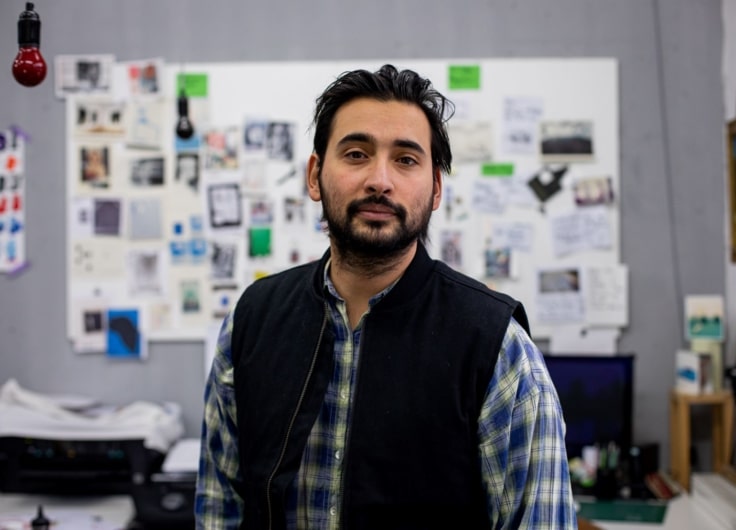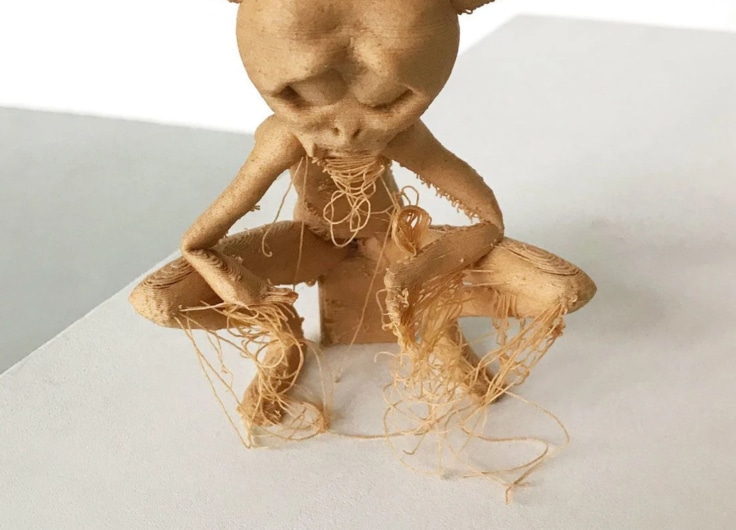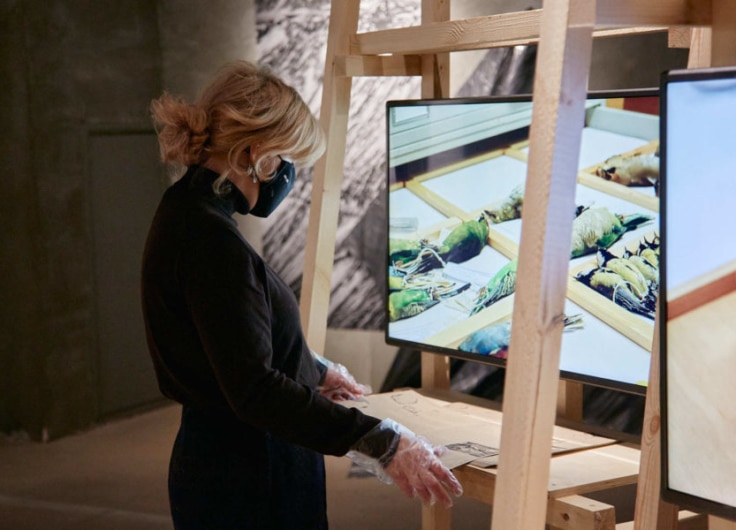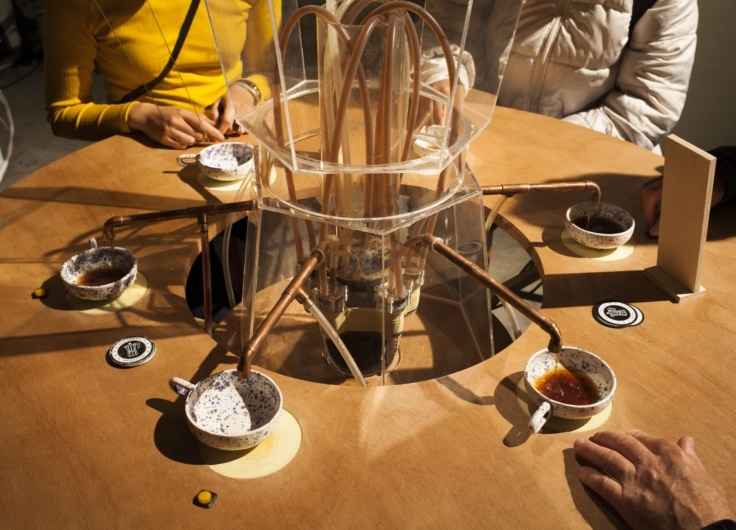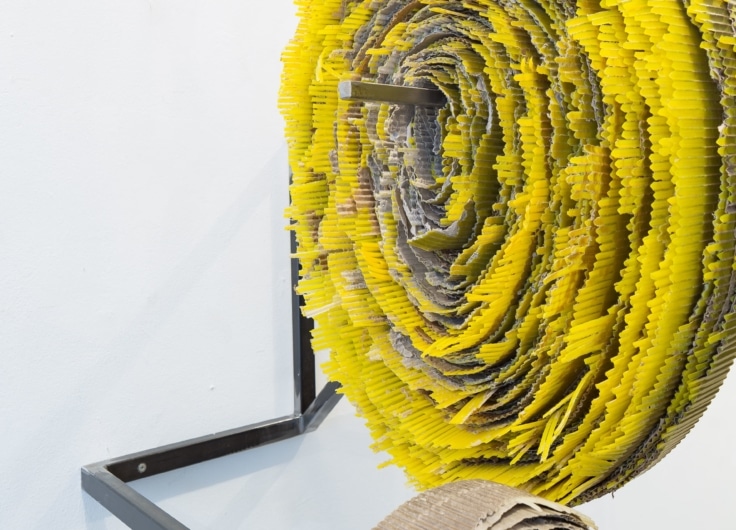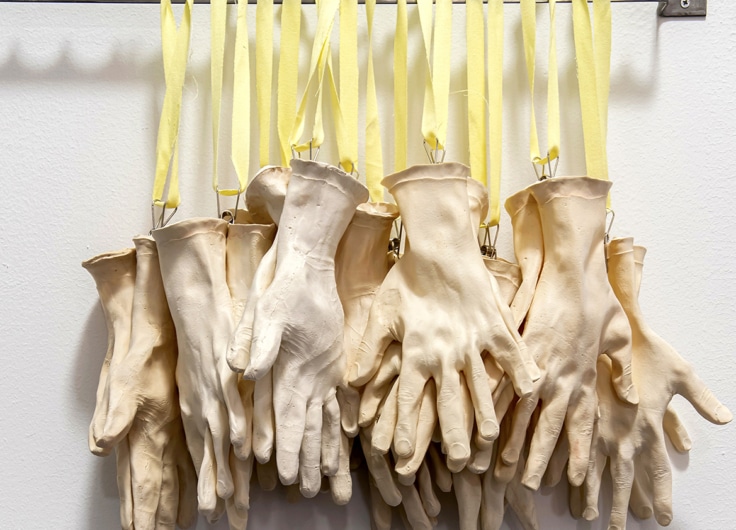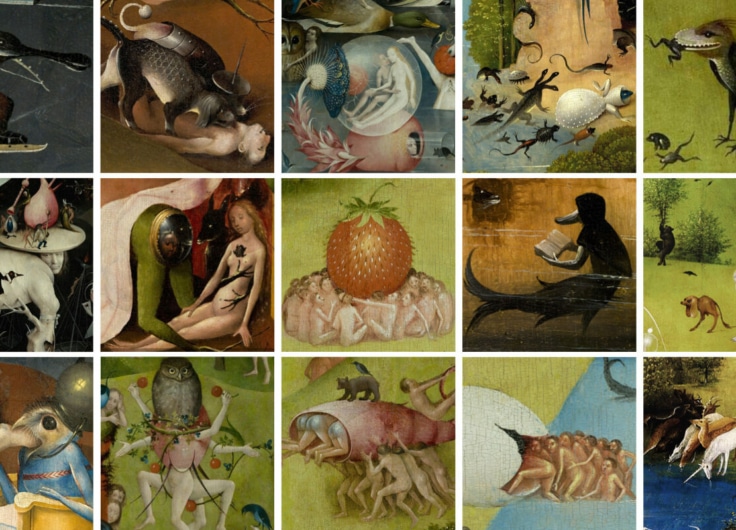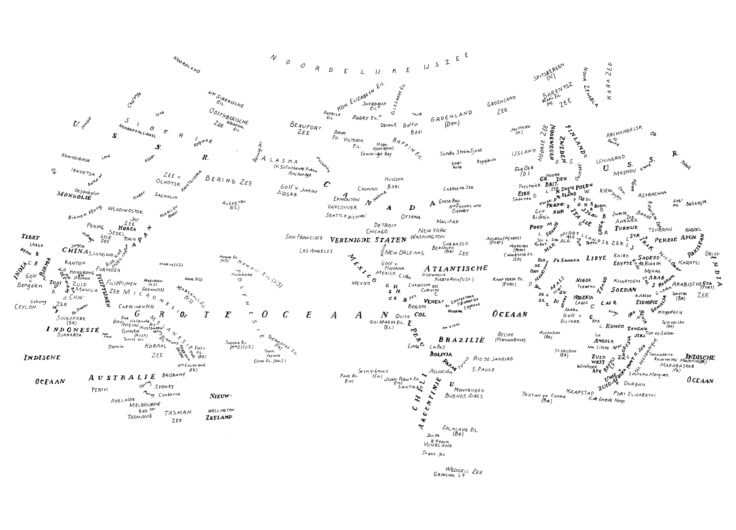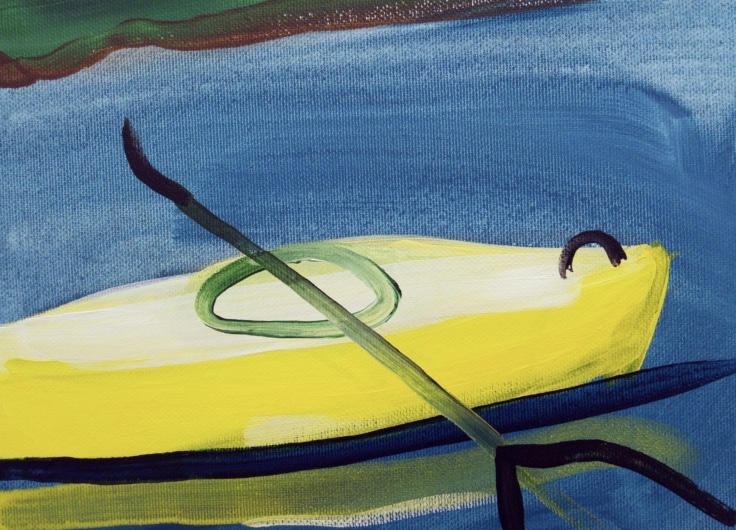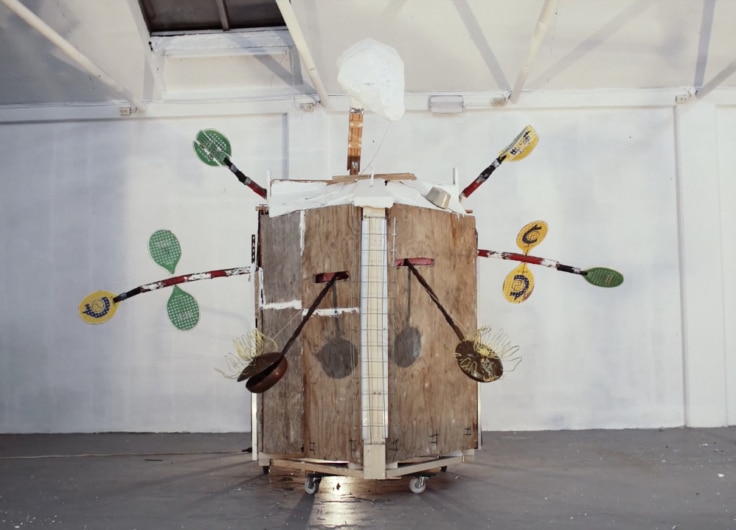Dennis Tyfus Improvises to Open Up Your Head
Who is Dennis Tyfus? The Belgian total artist cannot be pinned down. The exhibition Don’t Tell Me Not to Tell You What to Do in De Warande in Turnhout made no attempt to do this, and instead chose to display a colourful collection of his fantasies. In the form of works of art but also concerts, tattoo sessions and ‘unforeseeable activities’ – where the visitor may never get to see the exhibition.
“It is strictly forbidden to give directions or tips to the driver of a ‘No Choice Taxi’. Those who do not like surprises, adventure or general humour and improvisation, should not use the ‘No Choice Taxi’.”
Right at the entrance of De Warande in Turnhout, where Dennis Tyfus (b. 1979) exhibited, you already stumbled across the No Choice Taxi. If you hopped in, the driver determined where you would be taken. And that was “only going somewhere, never going back”. “I like that thought,” said Tyfus. “You may never get to see the rest of the exhibition.”
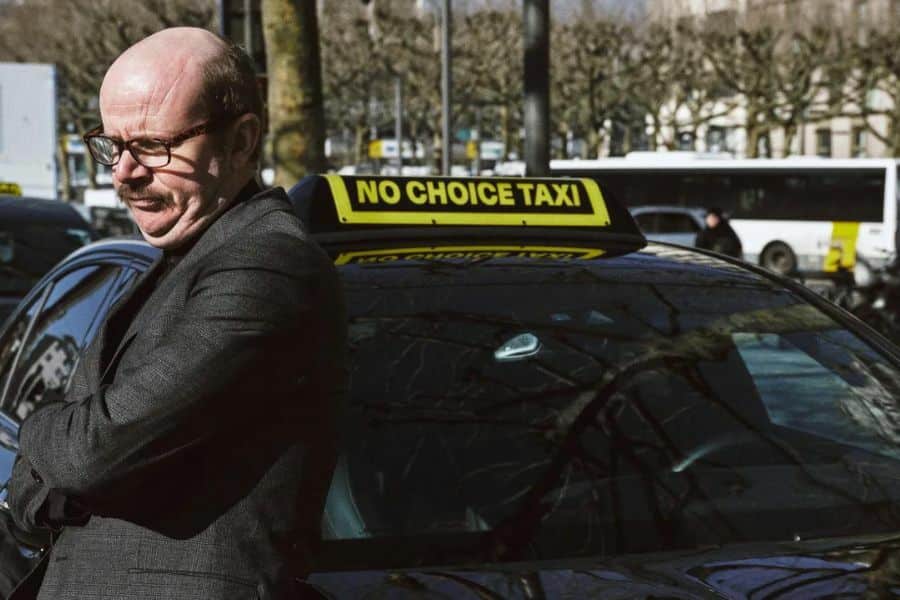 Dennis Tyfus and his No Choice Taxi. If you hop in, the driver determines where you will be taken.
Dennis Tyfus and his No Choice Taxi. If you hop in, the driver determines where you will be taken.© Charlie De Keersmaecker
Anyone who simply called Don’t Tell Me Not to Tell You What to Do ‘an exhibition’ was doing the whole thing an injustice. In addition to exhibited works, the exhibition also included lectures, debates, performances, concerts, tattoo sessions and activities such as the No Choice Taxi.
It shows that Tyfus cannot be subsumed under one heading. The Antwerp total artist himself seems to have only recently realised this. “Somehow it goes without saying that I combine all my different activities and work. But it actually took me until now to really pull it off. A lot comes together in this exhibition: my drawings and sculptures, but also music, a presentation room for performances and lectures, the characters I play in my radio show or on social media.”
Educated by radio
It is difficult to find a starting point in Tyfus’ massive oeuvre and wide-ranging career, who is active as a visual artist, radio maker, graphic designer, musician and publisher.
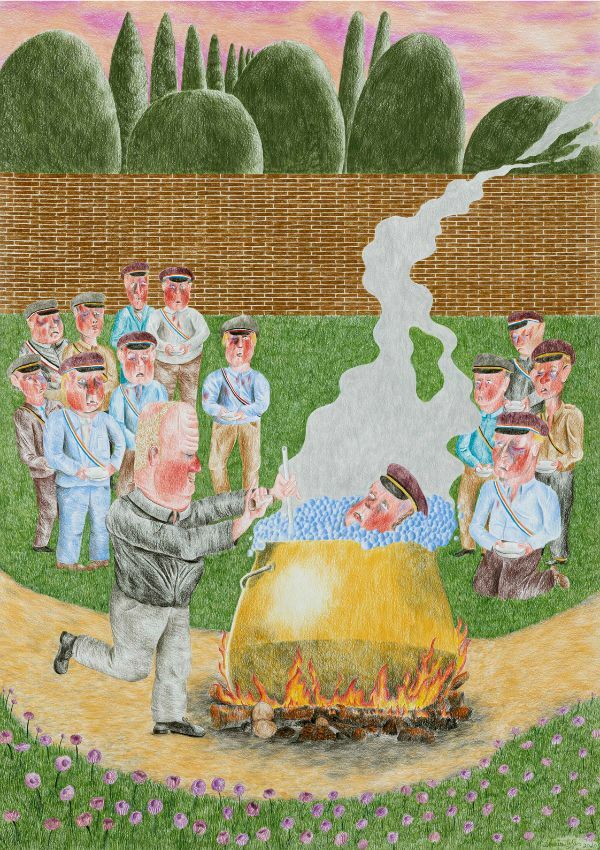 A Feast, 2022
A Feast, 2022© Tim Van Laere Gallery
Tyfus is best known for his series of drawings known as Up-And Downgrades. In it, the artist – or rather: a figure grafted onto his physique – is central to various surrealist situations. These situations are inspired by current events or popular culture – from black metal band photos to the film A Christmas Story. Or simply by a clever pun: in 2021, a series of drawings where members of the Nationalist Student Association (NSV) were quite literally pilloried or roasted and even subject to being grilled by the police. (In his defence, Tyfus labelled the images an “out-of-control baptismal ritual.”)
He himself considers his early entry into the Antwerp non-commercial independent station Radio Centraal as a key moment. “Radio Centraal was founded in 1980, I ended up there as a teenager. It was a highly diverse mixture of scenes, generations and influences: situationists and punks rubbed elbows, and all kinds of musical niches such as hip-hop and noise found a place there. They also had radio programmes about visual arts, Radio Centraal fulfilled the role of an academy for me.”
Hand tattoos, beer glasses and a soccer football team
The musical underground has always played a key role in Tyfus’ work, especially through the publications on his own publishing house Ultra Eczema. What started as what he called a “terribly bad” DIY magazine quickly became a genuine record label. Initially, Tyfus released his own productions on the label, often under the name Vom Grill. Artist friends or admirers also appeared on Ultra Eczema.
Tyfus regularly seizes the opportunity to delve into the archive of a local artist he perceives as forgotten or undervalued: Gust Gils, George Smits, Paul de Vree, Wout Vercammen, Edmond De Deyster … Archiving may not be Ultra Eczema’s main goal, but it is a valuable side effect.
For Tyfus, who didn’t study art history, it’s all about that process of searching and discovering what you find good or interesting. “You can’t get any closer to the essence of the artist than by diving into his or her archive or talking to friends and family. You suddenly learn everything about that person.”
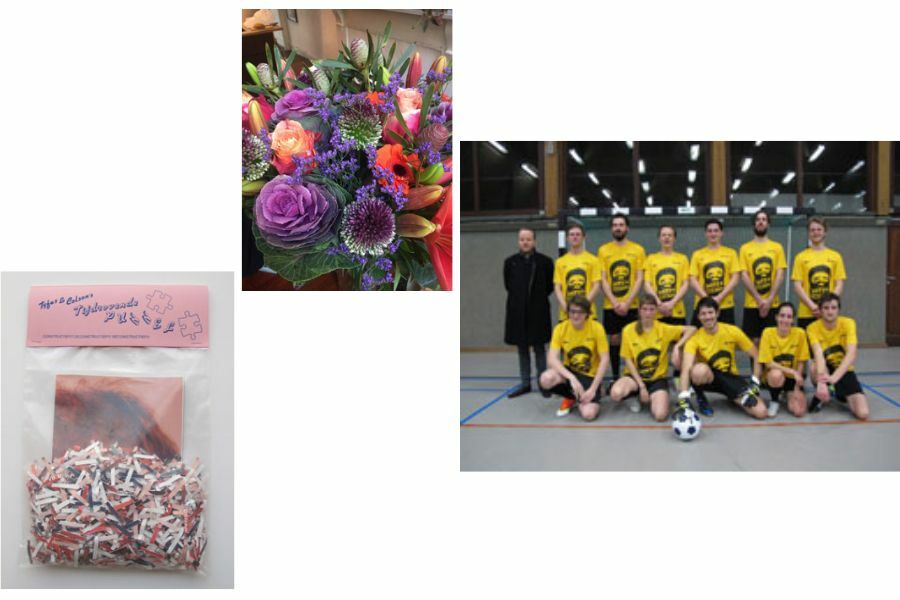 A selection from the Ultra Eczema collection: Time-consuming puzzle (UE172; with Vaast Colson), A No Choice forty-course dinner for Dennis Tyfus' 40th birthday (UE280) and Soccer Team (UE164)
A selection from the Ultra Eczema collection: Time-consuming puzzle (UE172; with Vaast Colson), A No Choice forty-course dinner for Dennis Tyfus' 40th birthday (UE280) and Soccer Team (UE164)© Dennis Tyfus / Ultra Eczema
Tyfus initially made the covers for records and tapes for the recording artists on Ultra Eczema. Along the way, he also added other objects and interventions to the collection: books, prints, T-shirts, a tattoo on his own hand (UE50), a set of beer glasses (UE158), a football team (UE164), a time-consuming puzzle (UE172) or a forty-course dinner for his fortieth birthday (UE280).
Each time, these objects were linked to an exhibition, a new work or an event that Tyfus organized. Thus, the Ultra Eczema catalogue also became a way for the artist to organize his own work. It is not a complete or even representative overview. It’s simply … something.
Urban Village Feeling
Tyfu’s earliest works were flyers or posters for events he organized in his hometown Antwerp, mainly in squats such as Scheld’Apen
and Het Noordkasteel, or in the spaces he decorated himself, such as Gunther
and Stadslimiet. Invariably, they were places where like-minded artists could meet and collaborate. This gives the impression of an Antwerp ‘scene’ that has developed around Ultra Eczema. But according to Tyfus, it is nothing more than a logical consequence of the specific Antwerp character trait.
“Antwerp is a base for my practice as an artist, and a stop within an international network of like-minded people where I can receive other artists myself. I don’t have a ‘roots’ feeling: where I was born and raised seems to me to be a coincidence. I think chauvinism and nationalism are rather bad phenomena.”
'I don't have a "roots" feeling: where I was born and raised seems to me to be a coincidence. I think chauvinism and nationalism are rather bad phenomena'
Although Tyfus likes the mentality that prevails in the city: “Antwerp is a village with the arrogance of a big city. Precisely because it is so small here, several overlapping generations of artists quickly come into contact with each other. You meet each other often, and everyone goes to the same places for performances and exhibitions. That fosters a kind of quick formation of a movement. Organizing things myself is pretty much my social life.”
Here Lies Dennis Tyfus
The events and spaces that Dennis Tyfus organizes, just like his label, are an inseparable part of his artistic work. In the meantime, he is part of the prestigious Tim Van Laere Gallery, and he is asked for exhibitions at iconic places such as the Middelheim Museum. His previous DIY initiatives did not arise as a reaction to the established institutions, Tyfus organized them out of sheer necessity and out of an urge to share his enthusiasm with a community of like-minded people.
“When we became enthusiastic about a work or artist, we simply used that feeling to do something with it ourselves. We’d rather do that than wait for someone else’s initiative. I think that’s a logical way of working, I’m pragmatic about it. I have set up spaces to show work or music in them that I did not see anywhere else, but that is not automatically a criticism of the institutions. I think such things can coexist perfectly well.”
'I have set up spaces to show work or music in them that I did not see anywhere else, but that is not automatically a criticism of the institutions'
The architectural sculpture De Nor (The Jail) in the Middelheim sculpture park is exemplary in that respect. “When I was asked by the Middelheim Museum for an exhibition, my first idea was to set up a pavilion there. The museum has some very nice specimens, but I have rarely seen them activated – they are there mainly because of their architecture. De Nor can still be viewed as a sculpture, but in the summer, it is activated with performances, lectures, and concerts. Programming is now an inherent part of the work.”
In fact, this playful dialogue with society is a prominent constant feature of Tyfus’ work. A funny brain wave can be the reason for a work that then seeks its place in the environment, without imposing itself. You can follow the many associative lines that lead to going into it more deeply – or not if you don’t feel like it.
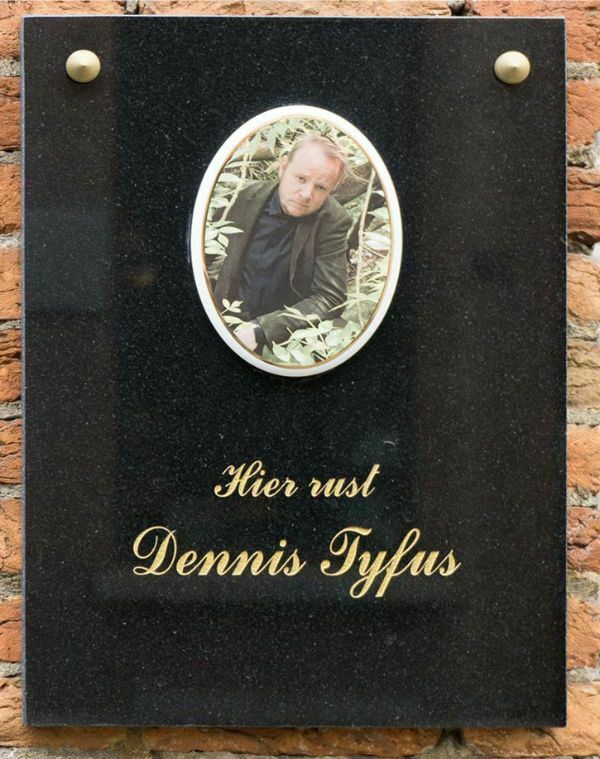 Here lies Dennis Tyfus, 2016
Here lies Dennis Tyfus, 2016© Tim Van Laere Gallery
Take for instance, the work that Tyfus produced for the Antwerp open-air exhibition 11 artists against the wall (2016). He had a placard installed on the façade of his studio in the Wolstraat with the text “Here rests Dennis Tyfus”. It was supposed to point out to Tyfus and people passing by that his studio has a calming effect on him.
Ultra Eczema 100 is another example of Tyfus’s “public art”. The catalogue number is printed on a road sign with a blue arrow indicating the distance to a place in Belgium. Tyfus designed the sign for his solo exhibition My Niece’s Pierced Knees at the Middelheim Museum (2018). Today it is part of the permanent collection – although it is located right next to the park on the public road.
Freedom
With the No Choice Taxi at De Warande, Tyfus also zeros in on the public space. In the past, he often experimented with the concept of “no choice”, where he plays with the nature of obligations and choices. He regularly makes No Choice Tattoos, where the recipient has no say in the design that will adorn his body. These days you can also acquire a No Choice Vinyl: you get a record and have to guess what’s on it.
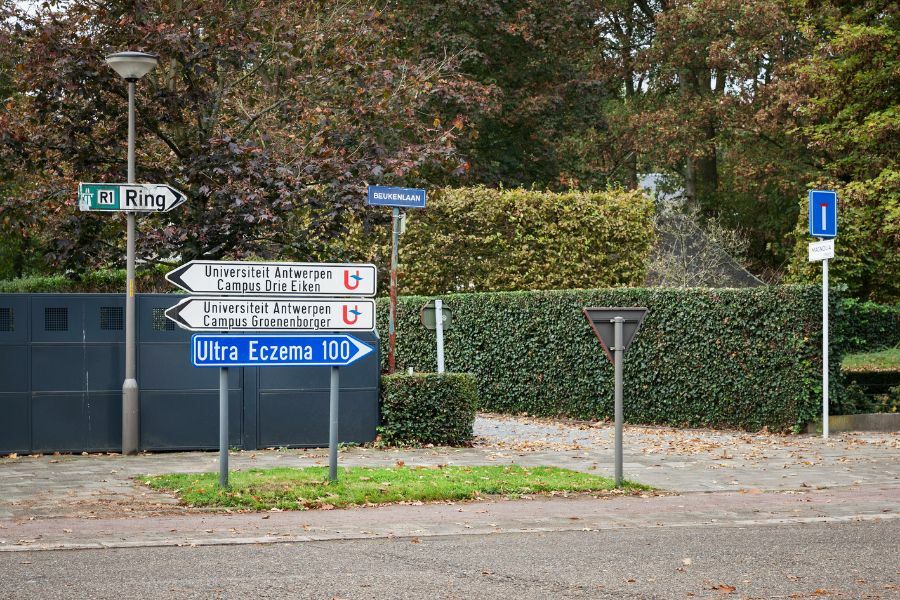 Ultra Eczema 100, 2015
Ultra Eczema 100, 2015© Dennis Tyfus
“I don’t view the ‘no choice’ idea as patronising. It’s not my intention to show how little freedom of choice we have; I daresay that sometimes there is too much choice. Rather, you can think of it as a parody of life itself. For me, it has become a kind of working material or working framework.”
Tyfus does not have to think long about what the most important element of his work is. “Improvisation is a key concept in everything I do. At best, it changes the way you look at the world. In an improvisation, unwritten rules arise. Then it becomes important to reverse those rules and change them back, so that the freedom of improvisation is preserved. Which of course makes you draw up new rules, what a contradiction! Finding those contradictions, questioning them and reversing them in order to arrive at something new – that’s pretty much what it’s all about.”
Dennis Tyfus, Hannibal, 2023, 260 pages

